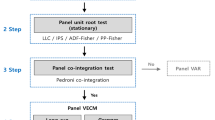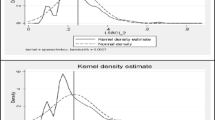Abstract
The relationship between shipping accessibility and maritime transport demand is studied based on the relationship between production and consumption and stochastic frontier analysis. First, the consumption market of the products produced in a region is classified into the local market, non-local domestic market and foreign market. Then, to obtain the potential export volumes, the production function, extended linear expenditure system model, and multi-regional input-output model are built to calculate the regional production, the consumption in local market, and the consumption in non-local market, respectively. Second, the impact of potential export volumes and shipping accessibility on maritime transport demand is studied based on the stochastic frontier gravity model. Finally, the data from 2006 to 2012 for eight domestic regions and eight overseas regions were used to conduct an empirical study. The findings indicate that the maritime transport demand is positively correlated with shipping accessibility and that the region with higher accessibility has the greater demand. Furthermore, adding shipping lines in Quanzhou Port had the largest positive effect on Chinese exports.






Similar content being viewed by others
References
Alamá-Sabater L, Márquez-Ramos L, Suárez-Burguet C (2013) Trade and transport connectivity: a spatial approach. Appl Econ 45(18):2563–2566
Aigner D, Lovell CK, Schmidt P (1977) Formulation and estimation of stochastic frontier production function models. J Econ 6(1):21–37
Baier SL, Bergstrand JH (2001) The growth of world trade: tariffs, transport costs, and income similarity. J Int Econ 53(1):1–27
Bensassi S, Márquez-Ramos L, Martínez-Zarzoso I, Suárez-Burguet C (2015) Relationship between logistics infrastructure and trade: Evidence from Spanish regional exports. Transp Res A Policy Pract 72:47–61
Bougheas S, Demetriades PO, Morgenroth EL (1999) Infrastructure, transport costs and trade. J Int Econ 47(1):169–189
Calatayud A, Palacin R, Mangan J, Jackson E, Ruiz-Rua A (2016) Understanding connectivity to international markets: a systematic review. Transp Rev 1–24. https://doi.org/10.1080/01441647.2016.1157836
Carrasco R, Albarran P, Holl A (2009) Transport infraestructure, sunk costs and firms' export behaviour. Universidad Carlos III de Madrid. Departamento de Economía
Caschili S, Medda F, Parola F, Ferrari C (2014) An analysis of shipping agreements: the cooperative container network. Netw Spat Econ 14(3–4):357–377
Chi J (2016) Exchange rate and transport cost sensitivities of bilateral freight flows between the US and China. Transp Res A Policy Pract 89:1–13
China Statistical Year Book (2014) The total imports and exports of China (in Chinese). http://navi.cnki.net/KNavi/YearbookDetail?pcode=CYFD&pykm=YINFN&bh. Accessed 12 May 2015
Clark X, Dollar D, Micco A (2004) Port efficiency, maritime transport costs, and bilateral trade. J Dev Econ 75(2):417–450
Cook WD, Zhu J (2014) DEA Cobb–Douglas frontier and cross-efficiency. J Oper Res Soc 65(2):265–268
Coşar AK, Demir B (2016) Domestic road infrastructure and international trade: Evidence from Turkey. J Dev Econ 118:232–244
Drysdale P, Huang Y, Kalirajan KP (2000) China’s trade efficiency: Measurement and determinants. In: Drysdale P, Zhang Y, Song L (eds) APEC and liberalization of the Chinese economy. Asia Pacific Press, Canberra, pp 259–271
Fabling R, Grimes A, Sanderson L (2013) Any port in a storm: impacts of new port infrastructure on exporter behaviour. Transport Res E Log 49(1):33–47
Homsombat W, Ng A, Fu X (2016) Regional transformation and port cluster competition: the case of the pearl river delta in South China. Growth Chang 47(3):349–362
Huang JL (2008) Market size and industrial growth in Chinese provinces. China Econ Q 7(4):1317–1334 (in Chinese)
Hummels D (2007) Transportation costs and international trade in the second era of globalization. J Econ Perspect 21(3):131–154
Lee TC, Wu CH, Lee PTW (2011) Impacts of the ECFA on seaborne trade volume and policy development for shipping and port industry in Taiwan. Marit Policy Manag 38(2):169–189
Limao N, Venables AJ (2001) Infrastructure, geographical disadvantage, transport costs, and trade. World Bank Econ Rev 15(3):451–479
Lu XD, Zhao QW (2010) China’s export potential and determinants. J Quant Tech Econ 10:21–35 (in Chinese)
Márquez-Ramos L, Martínez-Zarzoso I, Pérez-García E, Wilmsmeier G (2011) “Special issue on Latin-American research” maritime networks, services structure and maritime trade. Netw Spat Econ 11(3):555–576
Martínez-Zarzoso I, García-Menéndez L, Suárez-Burguet C (2003) Impact of transport costs on international trade: the case of Spanish ceramic exports. Marit Econ Logist 5(2):179–198
Martínez-Zarzoso I, Suárez-Burguet C (2005) Transport costs and trade: empirical evidence for Latin American imports from the European Union. J Int Trade Econ Dev 14(3):353–371
Martinez-Zarzoso I, Pérez-García EM, Suárez-Burguet C (2008) Do transport costs have a differential effect on trade at the sectoral level? Appl Econ 40(24):3145–3157
Notteboom T, Yang Z (2017) Port governance in China since 2004: Institutional layering and the growing impact of broader policies. Res Transp Bus Manag 22:184–200
Palacio A, Adenso-Díaz B, Lozano S, Furió S (2016) Bicriteria optimization model for locating maritime container depots: application to the port of Valencia. Netw Spat Econ 16(1):331–348
Portugal-Perez A, Wilson JS (2012) Export performance and trade facilitation reform: hard and soft infrastructure. World Dev 40(7):1295–1307
Ramli MKR, Ismail NW (2014) Role of infrastructures in explaining trade costs in ASEAN-5. Eng Econ 25(2):119–129
Sánchez RJ, Hoffmann J, Micco A, Pizzolitto GV, Sgut M, Wilmsmeier G (2003) Port efficiency and international trade: port efficiency as a determinant of maritime transport costs. Marit Econ Logist 5(2):199–218
Shi R, Hu Z, Zhou Y, Liu P (2014) Research on railway freight market share based on the whole process of transport. Procedia Soc Behav Sci 138:298–304
Song DW (2002) Regional container port competition and co-operation: the case of Hong Kong and South China. J Transp Geogr 10(2):99–110
Tang LC, Low JM, Lam SW (2011) Understanding port choice behavior—a network perspective. Netw Spat Econ 11(1):65–82
Thill JC, Lim H (2010) Intermodal containerized shipping in foreign trade and regional accessibility advantages. J Transp Geogr 18(4):530–547
Tinbergen J (1962) Shaping the world economy: suggestions for an international economic policy. The Twentieth Century Fund, New York
Tsiotas D, Polyzos S (2015) Analyzing the maritime transportation system in Greece: a complex network approach. Netw Spat Econ 15(4):981–1010
Wang K, Ng A, Lam J, Fu X (2012) Cooperation or Competition? Factors and Conditions Affecting Regional Port Governance in South China. Marit Econ Logist 14(3):386–408
Wang L, Béland D, Zhang S (2014) Pension fairness in China. China Econ Rev 28:25–36
Wang Y, Cullinane K (2008) Measuring container port accessibility: An application of the Principal Eigenvector Method (PEM). Marit Econ Logist 10(1):75–89
Wang YF, Liu SL (2015) Dynamic effect of government spending structure on household consumption——empirical analysis based on DSGE model. Syst Eng Theory Pract 35(2):300–307 (in Chinese)
Wilmsmeier G, Hoffmann J (2008) Liner shipping connectivity and port infrastructure as determinants of freight rates in the Caribbean. Marit Econ Logist 10(1):130–151
WTO (2014) The seaborne trade shipments of each country. http://stat.wto.org/Home/WSDBHome.aspx?Language. Accessed 25 July 2015
Xu LZ, Fang SC, Wang SY (2012) Analysis on transport costs and China's exports. Syst Eng Theory Pract 32(5):1057–1067 (in Chinese)
Yang D, Ong GP, Chin ATH (2014a) An exploratory study on the effect of trade data aggregation on international freight mode choice. Marit Policy Manag 41(3):212–223
Yang J, Wu X, Luo M (2014b) Regional economy, transportation infrastructure and container port system evolution process: a comparative study of China and the U.S. in 1979-2010. Econ Geogr 34(2):80–85
Zeng Q, Qu C (2014) An approach for baltic dry index analysis based on empirical mode decomposition. Marit Policy Manag 41(3):224–240
Zhang R, Huang K (2009) Path analysis of influential elements of collecting and dispatching system for container port. J Tongji Univ Nat Sci 37(1):57–62 (in Chinese)
Zhao Y, Kockelman KM (2004) The random-utility-based multiregional input–output model: solution existence and uniqueness. Transp Res B Methodol 38(9):789–807
Zhuang W, Luo M, Fu X (2014) A game theory analysis of port specialization—implications to the Chinese port industry. Marit Policy Manag 41(3):268–287
Acknowledgements
This research is supported by the key project of National Natural Science Foundation of China (Grant No. 71431001) and the Fundamental Research Funds for Central Universities of China (Grant No. 3132016303).
Author information
Authors and Affiliations
Corresponding author
Appendix
Appendix
Rights and permissions
About this article
Cite this article
Guo, L., Yang, Z. Relationship Between Shipping Accessibility and Maritime Transport Demand: the Case of Mainland China. Netw Spat Econ 19, 149–175 (2019). https://doi.org/10.1007/s11067-018-9393-2
Published:
Issue Date:
DOI: https://doi.org/10.1007/s11067-018-9393-2




